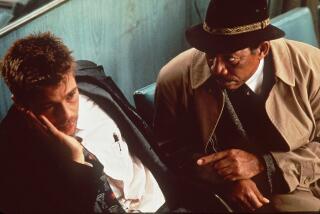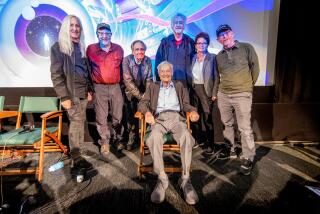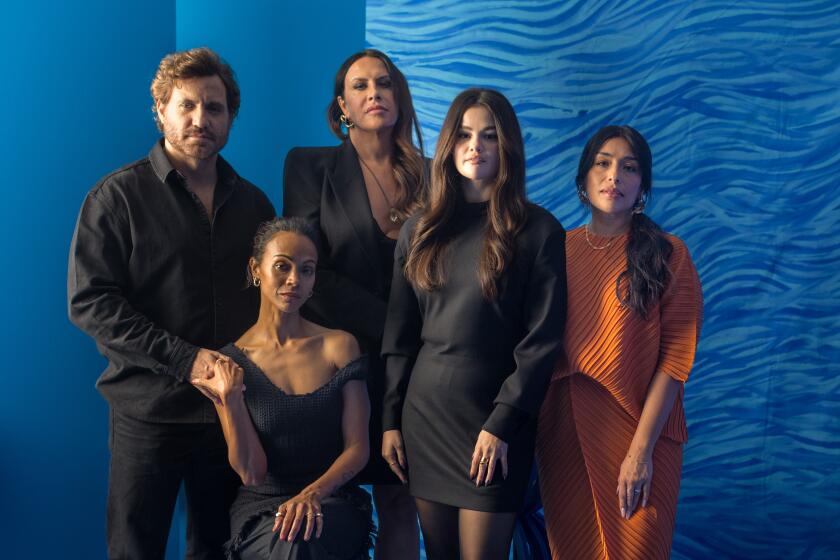Russ Meyer, 82; Iconic Sexploitation Filmmaker
Russ Meyer, a master of sexploitation filmmaking who was called “king of the nudies” or “King Leer” for such soft-core pornography classics as “Faster, Pussycat! Kill! Kill!” and “Vixen,” has died. He was 82.
Meyer, who also directed the major studio release “Beyond the Valley of the Dolls,” died Saturday at his home in the Hollywood Hills, according to his company, RM Films International Inc. Spokeswoman Janice Cowart said Meyer had suffered from dementia and died of complications of pneumonia.
Something of a one-man studio, Meyer produced, directed, financed, wrote, edited and shot 23 tantalizing but teasing films that pioneered a genre of skinflicks with much violence and large-busted women but little sex. The titles of the X-rated fare that made him millions are descriptive -- “The Immoral Mr. Teas,” “Erotica,” “Wild Gals of the Naked West,” “Heavenly Bodies,” “Mudhoney,” “Mondo Topless,” “Common Law Cabin,” “Supervixens” and “Europe in the Raw.”
“I love big-breasted women with wasp waists,” he told the London Times in 1999, two decades after making his final film. “I love them with big cleavages.” Little wonder that Time magazine critic Richard Corliss called Meyer’s films “bosomacious melodramas” or that Meyer came to be viewed as an auteur.
But with age came grace -- and admiration -- as Meyer’s work was honored at film festivals around the world including at the American Cinematheque in Hollywood and the National Film Theater in London. His movies were discussed in classes at Yale and Harvard, and purchased by such respectable institutions as the New York Museum of Modern Art.
In 2002, an exhibit of his striking pinup and studio still photos from the 1950s and 1960s was staged at the prestigious Feigen Gallery in New York, which also handles the work of the late caricaturist Al Hirschfeld.
When the Russ Meyer Film Festival opened at Los Angeles’ Vagabond Theater in 1992, Times film writer Kevin Thomas wrote: “No one projects heterosexual male sex fantasies with greater gusto and resolute dedication than Meyer, who at heart is a puritan and who has always been a bigger tease than any burlesque queen. His world is populated with an abundance of pneumatic women carefully photographed to make them look as cantilevered as possible, dirty old men and blockhead heroes plus dialogue heavy with double-entendre.”
By the time Meyer made “Vixen” in 1969, Thomas wrote in the 1992 article on the festival, “Meyer pictures had begun to look like good clean fun for adults, and with great disarming heartiness he tackles not only adultery, homosexuality and incest but also takes a couple of potshots at communists and racial prejudice.”
Meyer’s films continue to engender debate, which may explain their popularity in film classes at USC and across the country. A San Francisco Chronicle critic labeled the 1966 “Faster, Pussycat! Kill! Kill!” as “the worst film ever made,” but director John Waters has called it “beyond doubt, the best movie ever made ... possibly better than any film that will ever be made in the future.” (The film fared poorly at the box office in its original release but was a hit on the art house circuit 30 years later.)
In further homage, three rock groups have named themselves for Meyer films -- Mudhoney, Vixen and Faster Pussycat.
Because of Meyer’s uncanny ability to produce visual films on a low budget -- his initial “The Immoral Mr. Teas” in 1959 returned $1 million on his $24,000 investment and the 1969 “Vixen” earned $6 million on a $76,000 investment -- then-20th Century Fox president Richard D. Zanuck hired Meyer for mainstream studio projects.
First came 1970’s “Beyond the Valley of the Dolls,” a satirical in-name-only sequel to 1967’s “Valley of the Dolls” made from the bestselling Jacqueline Susann novel. Written by movie critic Roger Ebert, the X-rated sequel proved popular and in many ways a better movie than the original. As Leonard Maltin says in his 2004 Movie and Video Guide, two “prominent critics” even selected “Beyond” as one of the 10 best U.S. films from 1968 to 1978.
The film was Meyer’s favorite. “It is by far the most important film I ever made,” he told the Toronto Star in 1995. “Roger and I embrace that one to our bosoms, or co-bosoms.”
Ebert evaluated Meyer’s oeuvre in an article in Playboy in 1995, the year “Beyond” recirculated: “Meyer uses his productions, I believe, to recapture the joy he felt during the formative and most enjoyable period of his life -- the war. It was then that he formed lifelong friendships, discovered his skill as a cameraman and experienced, in a French bordello, his sexual awakening with a buxom partner who became the archetype of the R.M. woman.”
Pleased with Meyer’s work on “Beyond,” Zanuck handed him “The Seven Minutes,” which was based on Irving Wallace’s bestselling novel about a pornography trial. But the mainstream 1971 film, featuring such well-known character actors as Philip Carey, Yvonne De Carlo and John Carradine and also Meyer’s onetime wife Edy Williams, failed at the box office.
Meyer returned to his own RM Films International Inc. and made movies that were fodder for drive-in theaters and audiences not quite ready for the blatant sex that later became standard fare. As drive-ins dwindled and tastes changed, Meyer wound down his filmmaking with “Beneath the Valley of the Ultravixens” in 1979.
In recent years, he had discussed making another film with Ebert to be titled “The Bra of God.” But the project never materialized.
Born in Oakland on March 21, 1922, Meyer was the son of a police officer and a nurse. With money borrowed from his mother, he bought an 8-millimeter Univex “picture-taking machine” when he was 12 and began making amateur films.
He was in junior college when an ad for combat photographers for the Army Signal Corps lured him to Hollywood. Sent to France and Germany, Meyer was credited with shooting combat films and newsreels under some of the most dangerous conditions in World War II.
At the same time, he was honing skills for high-speed, somewhat disjointed cinematography that would force grudging critics to admire his art, however vulgar. Even critics who panned his movies praised his work behind the camera.
After the war, Meyer worked as a cinematographer for Southern Pacific Railroad and occasionally was a still photographer on studio sets, including “Guys and Dolls” and “Giant.”
He also began photographing models for nude magazines and parlayed that expertise into photographing some of the first centerfold layouts for Playboy magazine. He married one of the playmates, Eve Turner, for whom he named his first company, Eve Productions.
In 1992, Meyer published his three-volume autobiography, “A Clean Breast: The Life and Loves of Russ Meyer” with such chapter titles as “Mammaries Are Made of This.”
Meyer married and divorced and lived with a series of models, playmates, strippers and actresses. His studio said he left no survivors.
Services will be private.
More to Read
Only good movies
Get the Indie Focus newsletter, Mark Olsen's weekly guide to the world of cinema.
You may occasionally receive promotional content from the Los Angeles Times.








